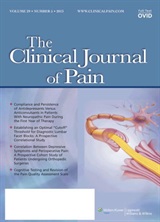
Long-Term Effects of Adding Sensorimotor Training to Manual Therapy & Exercise in Chronic Neck Pain

Long-Term Effects of Adding Sensorimotor Training to Manual Therapy & Exercise in Chronic Neck Pain
Changes in Multiple Aspects of Pain Outcomes After Rehabilitation: Analysis of Pain Data in a Randomized Controlled Trial Evaluating the Effects of Adding Sensorimotor Training to Manual Therapy and Exercise for Chronic Neck Pain.
Clin J Pain. 2024 Apr 1;40(4):212-220.Synopsis
One hundred fifty-two patients with chronic neck pain and sensorimotor deficits were randomized to receive either local neck treatment (NT) (n=38) or NT combined with sensorimotor training (joint position sense/oculomotor exercises, balance exercises, or both; n=114). The primary outcome of interest was changes in pain location, extent, and intensity. Secondary outcomes included disability, functi...
To view the full content, login to your account,
or start your 30-day FREE Trial today.
FREE TRIAL
LOGIN
Forgot Password?
Explore some of our unlocked ACE Reports below!

Learn about our AI Driven
High Impact Search Feature
Our AI driven High Impact metric calculates the impact an article will have by considering both the publishing journal and the content of the article itself. Built using the latest advances in natural language processing, OE High Impact predicts an article’s future number of citations better than impact factor alone.
Continue



 LOGIN
LOGIN

Join the Conversation
Please Login or Join to leave comments.